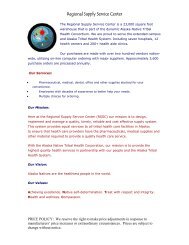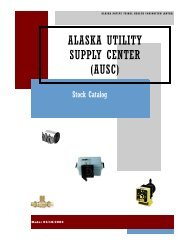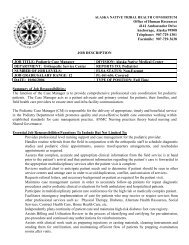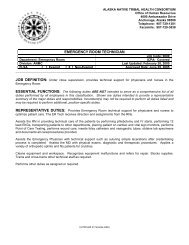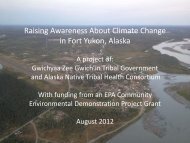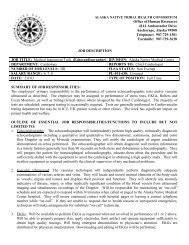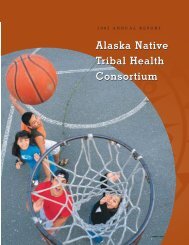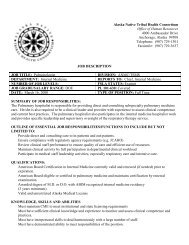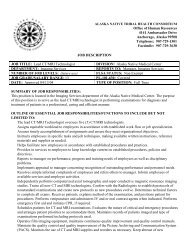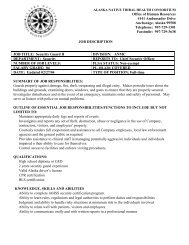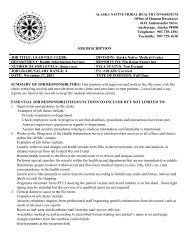McMahon - ANTHC
McMahon - ANTHC
McMahon - ANTHC
You also want an ePaper? Increase the reach of your titles
YUMPU automatically turns print PDFs into web optimized ePapers that Google loves.
Historical Background• Alaska Natives (AN) had the highestprevalence and incidence rate of hepatitis Bvirus (HBV) of any non immigrant group inUS– Incidence of HCC highest in AN in US• The highest rates of acute hepatitis A virusin US in most years up to 1995 was foundin Alaska
Geographic Distribution of HBVGenotypes in Alaska NativesCC, DA, B,D, FDD
Hepatitis B in Alaska Natives• 1972-73: High incidence acute hepatitis B• 1973-1974: Serosurvey found prevalence ofHBsAg in 12 villages in Southwest AK 6.4% (0-20.1%) 1• 1974-1978: Incidence study 1280 seronegativepersons: 14.8% HBV 2– 29% infected < 5 years became chronic carriers– Transmission mainly horizontal from child to childprobably through open cuts and scratches– HBsAg was found all over environmental surfaces(school lunchroom table tops, homes of carriers)1Schreeder Am J Epidemiol 1983; 118:543-92<strong>McMahon</strong> JID 1985; 151:599-603__
Intervention to Control HBV inAlaska: Questions in 1980• Can we halt the spread of HBV with thenew HBV vaccine?• If so, how long will protection last?• What about those chronically infected whowould not benefit by vaccination?– Can we detect hepatocellular carcinoma earlyenough to resect– Will we eventually be able to treat chronicHBV with antiviral therapy
Hepatitis B Vaccination in Alaska• 1981-82: Hepatitis B vaccine demonstrationproject in Southwest Alaska (Am J Epidemiol1985;121:914-923)• AN Hepatitis B Control Program: A collaborationbetween IHS, CDC, AN Health Corporations andState of Alaska with Congressional Funding• 1983-87: 53,000 Alaska Natives screened and40,000 susceptible were vaccinated• 1984: Hepatitis B vaccination of all infantsLancet, 1987; 330:1134-1136
Incidence Symptomatic Hepatitis B in AKNatives 1981- 2003Rate per 100,00022020018016014012010080604020019811983CDC/HIS Vaccine DemonstrationProgram begins in 16 villages ofYukon Kuskokwim Delta198519871989199119931995YearYukon Kuskokwim DeltaStatewideStatewide Program begins-all susceptibles immunized-pregnant women screened/infants HBvax + HBIG-begin universal newborns immunization199719992001200320052007
J Infect Dis 2000;181:413-418
How Long Does Protection afterHepatitis B Vaccine Last?• How fast does anti-HBs decay• Do break through HBV infections occur?• What are the implications of breakthroughinfections?• In persons who lose anti-HBs, canhumeral immunity be demonstrated– Anamnestic response to booster dose• Does cellular immunity last longest?
Long-Term Immunogenicity &Efficacy: Children & Adults• Alaska HBV Vaccine Demonstration Project: 1530children and adults immunized in1981– Followed yearly for 11 years and at year 15– No booster given at 1-11 and 15 years– % with anti-HBs levels > 10 mIU/ml• 5 years: 81% (JAMA 1989;261:2362-6)• 7 years: 74% (Arch Int Med 1991;151:1634-6)• 15 years, 66% (Ann Int Med;2005;142:333-41)• Test all participants for anti-HBs, HBsAg, anti-HBc– Sequence HBV DNA if HBsAg or anti-HBc+
Long-Term Immunogenicity &Efficacy: Alaska Study at 15 years• No chronic carriers or acute symptomatic HBVcases were identified• Anti-HBs GMC decreased from meanconcentration of 822 mIU/ml to 27 mIU/ml• 23 HBV breakthrough infections defined byappearance of anti-HBc• Significantly more breakthrough infections in nonresponders compared to responders• 6 were transiently HBV DNA positive, 4 of whomhad HBV surface mutants and one transientlyhad 145R escape mutant<strong>McMahon</strong> Ann Int Med 2005;142:333-41
Alaska HBV Vaccine DemonstrationProject: 22 Year Follow-Up• Residents of 7 villages, 9 villages not studied• % with anti-HBs levels > 10 mIU/ml– 5 years: 81%– 7 years: 74%– 15 years, 66%– 22 years 59%• Booster dose Recombivax® 5 mcg given tothose who with anti-HBs
Vax Demo 22: Study Design• Blood Draw/Boost schedule– Day 0: Pre booster draw/booster dose– Day 10-14: Post booster blood draw– Day 30-60 Post booster blood draw• Booster (anamnestic) response at 2weeks:– 4-fold anti-HBs increase, or– Increase to > 10mIU/mL
Vax Demo 22: Preliminary Results inPersons Who Responded to Initial Series• 5 persons anti-HBc positive (all previouslyidentified, all HBV DNA negative• 184 (41%) with anti-HBs 10 mIU/mL at 22 years
How Long Will Protection from HBVVaccine Last when Given at Birth?• Few studies beyond 10 years• Infants of HBsAg+ moms and/or thoseliving in an endemic environment havelonger persistence of anti-HBs• Demonstration of long-term immunity– Persistence of anti-HBs– Response to booster dose
Long-term Efficacy of HBV VaccineAdministered in Infancy: Alaska Study• 334 children immunized starting at birth withdocumented anti-HBs response >10 mIU/mlfollowed for up to 15 years (median 10 years)• At 5 years 49% who received plasma and only6% who received recombinant vaccine had anti-HBs levels > 10mIU/ml• At 10 years 21% who received plasma and 3%recombinant vaccine had anti-HBs > 10 mIU/mlPed Infect Dis J 2005;24:786-92
Long Term Persistence of Anti-HBs In AlaskaNative Children Immunized At Birth
Long-term Efficacy of HBV VaccineAdministered in Infancy: Alaska Study• 6 children had an HBV breakthroughinfection• None of these children were symptomaticor became HBsAg positive• 2 of these had HBV DNA transiently
Alaska Booster Dose Studies inChildren Given Recombinant HepatitisB Vaccine Starting at BirthAge at Boost % anti- No. No. (%)Moms HBV neg HBs >10 Boosted response5 years* 12.5% 134 90%5-7 years** 29% 158 99%7.5 years* 0% 35 91%10-15 years** 5% 138 88%15 years^ 0% 35 51%*Peds Infect Dis 2004;23:650-5, **Pediatrics 2007;120:373-381^Vaccine 2007;25:6958-64
Alaska Booster Dose Studies inChildren Given Plasma Hepatitis BAge at BoostVaccine Starting at Birth% anti-HBsNo.BoostedNo. (%)response9 yearsMom HBV-neg12 yearsMom HBV+13 yearsMom HBV-neg12-15 yearsMom HBV-neg41% 54 33 (67%)31% 10 9 (90%)24% 12 8 (67%)21% 74 71%
Anti-HBs levels following a booster doseof hepatitis B vaccine in HCW 3 to 13Years after Initial Vaccination10000010000mIU1000100101Booster Day 14 Day 28 1 year
Long-Term Protection withHepatitis B Vaccine: Conclusions• Hepatitis B Vaccine provides long-term protection• Immunity persists after loss of anti-HBs• Documented protection:– Lasts 15-18 years in infants– Up to 13 years in Health Care Workers– 22 years in children and adults• Lifelong protection is possible• No evidence “vaccine escape mutants” are a threat• Continued follow-up needed to determine duration ofprotection• Booster doses NOT currently recommended
Future Studies on Long-Term Efficacyof Hepatitis B Vaccine In Alaska• F/u up of all remaining participants in 1981immunogenicity study 30 years aftervaccination: Estimated number is ~900• F/u up of children who received a boosterdose of hepatitis B vaccine at school entryor adolescence to determine anti-HBspersistence after booster dose
Importance of Alaska Long-termHepatitis B Vaccine Studies• 1981 immunogenicity study is by far the largestand longest f/u study of HBV vaccine in theworld• This study is crucial to ACIP and othernational/international organizations futurerecommendations for booster dosing in children,adults and health care workers and thus far hasshown that no boosters are needed in thoseimmunized as children over 1 year of age oradults 22 years later
Hepatitis A Story in Alaska• 1984-1987: Study showed high rates ofpast hepatitis A infection*• 1987: Large epidemic begins• 1989: Hepatitis A vaccine trial in AlaskaNative and non-Native adults and children– <strong>McMahon</strong> J Infect Dis 1995;171:676-9• 1991: Hepatitis A vaccine licensed Europe• 1993: Hepatitis A outbreak stopped bygiving one dose of vaccine to 5000 people*J Infect Dis 1993;168:1017-20*Peach, J Infect Dis 2002;186:1081-5
Geographic Distribution of HAVInfection 1985Anti-HAV PrevalenceHighIntermediateLowVery Low
1600Figure 1: Reported Cases of Hepatitis A in the State of Alaska, 1957-200014001200Number of cases1000800600400200072 73 74 75 76 77 78 79 80 81 82 83 84 85 86 87 88 89 90 91 92 93 94 95 96 97 98 99Hepatitis AYear00
Hepatitis A OutbreakNorthwest AlaskaVaccinatedUnvaccinated302520151050Occurences-36 -32 -28 -24 -20 -16 -12 -8 -4 0 4 8 12 16 20 24 28 32 36 40 44 48 52 56 60Weeks Before/After VaccinationArch Pediatr Adolesc Med 1996;150:773-9
Alaska: The First State to OfferUniversal Hepatitis A Vaccine• Beginning in 1996, Hepatitis A vaccineoffered to all Native and non-Nativechildren ages 2-18 in Alaska: 1 st State inUS• Immunization results to date:– > 90% of all Alaskan children have beenvaccinated by school entry– Acute hepatitis A rate falls to lowest in Nationin 2004 (< 1 case per 100,000 persons)
Geographic Distribution of HAVInfection 2006Anti-HAV PrevalenceHighIntermediateLowVery Low
Hepatitis A: Current Projects• Long-term Immunogenicity and efficacystudies of Hepatitis A vaccine in adults,infants and children– 60 adults followed 10 years completed– 70 children, ages 3-6 f/u for 15 years• 100% still have anti-HAV at 10 years of age• Projected anti-HAV levels by modeling expected tolast at least 20-30 years– 206 infants f/u to 10 years
Anti-HAV Declination Curve following PrimaryHepatitis A Vaccination, according to Vaccination Schedule, Alaska100001000100
Alaska Hepatitis A Infant Study• Sites: ANMC & Anchorage Neighborhood HealthCenter• Randomized trial: 2 dose hepatitis A vaccine:infants stratified by Mothers anti-HAV status– Group 1: Vaccine 6 and 12 months of age– Group 2: Vaccine 12 and 18 months of age– Group 3: Vaccine 18 and 24 months of age• Response other childhood vaccines to detectmeasured to detect any interference from Hep APeds Infect Dis J 2007;26:116-22
Anti-HAV Concentrations at 7 and 12Months After First Hepatitis A VaccineDose, by Group, HAVIIS7 Months after Vaccine 12 Months after VaccineGroupN % Positive 1 GMC 2 95% CI 3 N % Positive 1 GMC 2 95%1N4310021821539 – 309544100741540 – 10171P3594809503 – 12993394226141 – 3641X1810024541452 – 414615100817508 – 13132N3810031662413 – 415642100882673 – 11572P3310022961719 – 306829100698499 – 9763N4310031992475 – 413638100915684 – 12233P3210027912102 - 370628100870604 - 12521Seropositivity based on anti-HAV concentration of 33 mIU/mL2Geometric Mean Concentration (mIU/mL). If anti-HAV
Long-Term Hepatitis A Vaccine inInfants• 206 infants f/u to 10 years• Plan to test sample of 7-year f/u bloods.• If anti-HAV is still present in > 90%, will wait until10-year sample complete (2008) before testingentire cohort.• If 10-year results show good immunogenicity,will continue study to 15 years and then test allparticipants samples again to decide on furtherf/u beyond 15 years
Importance on Alaska Hepatitis AStudies• Largest cohort of participants immunizedas children with longest f/u period in world• Largest cohort of participants immunizedas infants with longest f/u period in world• Studies are crucial to evaluate long-termeffectiveness of US strategy to immunizeall children between 1 and 18 years
Conclusions• Alaska has gone from the highest rates ofacute hepatitis A statewide and B inAlaska Natives in the US to the lowest rateof acute hepatitis A and B in the World(



